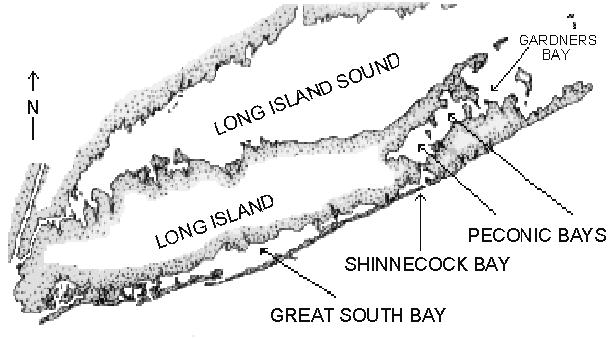Brown
Tide Research Initiative
ISSUE
Brown Tide, a microalgal bloom,
was first reported in the bays of eastern Long Island, NY, in June 1985. By
mid-summer of that year, it was clear that this organism resulted in the recruitment
failure of scallops in the Peconic Bay system. Another bloom and scallop failure
occurred in the summer of 1986. Although the brown tide organism, Aureococcus
anophagefferens, was detectable in Long Island waters in following years,
blooms on the order of those in 1985/86 did not occur. However, in the summer
of 1995, an intense brown tide bloom returned. In response to this problem
and public concern, the COP has initiated a coordinated program to understand
and predict the onset of brown tide blooms, and advance strategies for mitigating
its environmental impacts.

More generally, harmful algal
blooms (HABs) stand out as one of the most scientifically complex and nationally
relevant. In addition to Long Island, virtually every coastal state has reported
major blooms. These blooms may be responsible for more than $1 billion in
national losses. Harmful algal blooms can cause human illness and death, alter
marine habitats through shading and overgrowth, adversely impact fish and
other marine organisms, and close many coastal businesses.
APPROACH
A primary goal of this research
is to develop a predictive capability based on an understanding of how physical
and biological processes interact to promote bloom development, affect bloom
dominance, and contribute to bloom maintenance or decline. Knowing the causes
of these blooms will lead to identifying means to prevent them. Research is
focused on: 1) isolating the organism which is an important prerequisite for
further study; 2) identifying the factors that cause, maintain, and dissipate
blooms; and 3) determining the genetic diversity of the organism which could
lead to subsequent control strategies.
ACCOMPLISHMENTS
Preliminary research indicates
that there may be several possible growth factors and ecological influences
contributing to bloom development in Long Island. These factors include:
Brown tide organisms can
grow when other phytoplantkton cannot
- Aureococcus appears to have unique nutritional requirements and adaptive
capabilities allowing it to out-compete and even overwhelm other algal species.
Unlike many other species which predominately use inorganic (i.e., fertilizers)
nutrients, Aureococcus
can use organic nutrients.
Aureococcus
is not generally eaten by other organisms
- Data collected during the 1985-87 Narragansett Bay bloom showed that a significant
decrease in the number of grazing organisms (i.e., predators of Aureococcus
and other phytoplankton) was an important factor in the intensity and duration
of that bloom. Smaller, more localized blooms observed in the Peconic Estuary,
may be the result of local changes in the population of these grazing organisms.
Climate variability may
be a factor - Brown tide events also appear to be influenced by regional
climate variability. For instance, variations in precipitation will influence
runoff and groundwater discharge and flow, all of which factor into the loading
of nutrients, trace metals, and other growth stimulators (or inhibitors) to
coastal waters.
MANAGEMENT AND POLICY IMPLICATIONS
Harmful algal blooms are increasing
in number and intensity in U.S. coastal waters, generating serious problems
for fishing, tourism, and human health. Because so little is known about the
causes of HABs, responses have been cautious and often fragmented. NOAA's
Coastal Ocean Program, in collaboration with the New York Sea Grant Program,
have implemented efforts to improve management strategies for effectively
reducing HAB effects. Research findings are being fed directly to the Suffolk
County Health Department and the Peconic Estuary Program which are responsible
for developing management measures.
Related Websites
For
more information, contact:
Susan Banahan
CSCOR/Coastal
Ocean Program
phone:
301-713-3338
e-mail:
coastalocean@noaa.gov
Last Updated:
October 23, 2002



